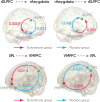Effects of exogenous testosterone application on network connectivity within emotion regulation systems
- PMID: 32047245
- PMCID: PMC7012825
- DOI: 10.1038/s41598-020-59329-0
Effects of exogenous testosterone application on network connectivity within emotion regulation systems
Abstract
Studies with steroid hormones underlined the vital role of testosterone on social-emotional processing. However, there is still a lack of studies investigating whether testosterone modulates network connectivity during resting-state. Here, we tested how the exogenous application of testosterone would affect functional connectivity between regions implicated in emotion regulation. In total, 96 male participants underwent resting-state fMRI scanning. Before the measurement, half of the subjects received 5 g TestimTM gel (containing 50 mg testosterone) and the other half a corresponding amount of placebo gel. Seeds for the connectivity analysis were meta-analytically defined. First, all regions associated with emotion regulation were chosen via Neurosynth (data driven). Among those, specific seeds were selected and categorized based on the neural model of emotion regulation by Etkin and colleagues (Etkin et al., 2015) (theory-guided). Resting-state connectivity analysis revealed decreased connectivity between the right DLPFC and the right amygdala as well as between the VMPFC and the left IPL for the testosterone group compared to the placebo group. A complementary dynamic causal modeling (DCM) analysis on findings from the resting-state connectivity analysis underlined a bidirectional coupling which was decreased close to zero by testosterone administration. Our results demonstrate that testosterone administration disrupts resting-state connectivity within fronto-subcortical and fronto-parietal circuits. The findings suggest that even without a specific task (e.g. challenge, reward processing) testosterone modulates brain networks important for social-emotional processing.
Conflict of interest statement
The authors declare no competing interests.
Figures




References
-
- Stenstrom E, Saad G. Testosterone, financial risk-taking, and pathological gambling. J. Neurosci. Psychol. Econ. 2011;4:254. doi: 10.1037/a0025963. - DOI
-
- Dashjav E., Lipińska-Chwałek M., Grüner D., Mauer G., Luysberg M., Tietz F. Atomic layer deposition and high-resolution electron microscopy characterization of nickel nanoparticles for catalyst applications. Surface and Coatings Technology. 2016;307:428–435. doi: 10.1016/j.surfcoat.2016.08.074. - DOI
Publication types
MeSH terms
Substances
LinkOut - more resources
Full Text Sources

